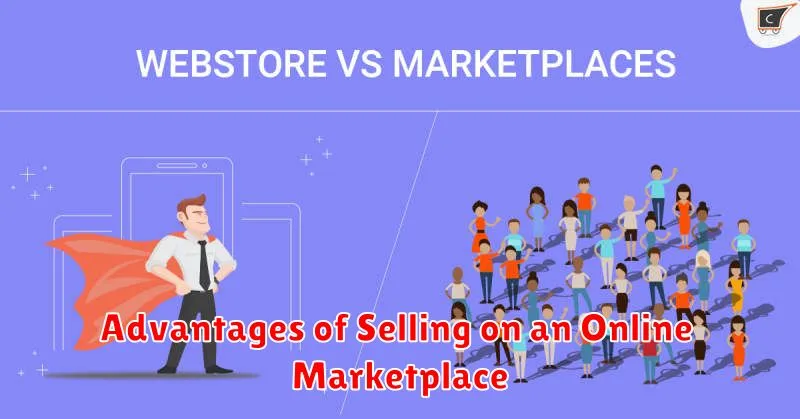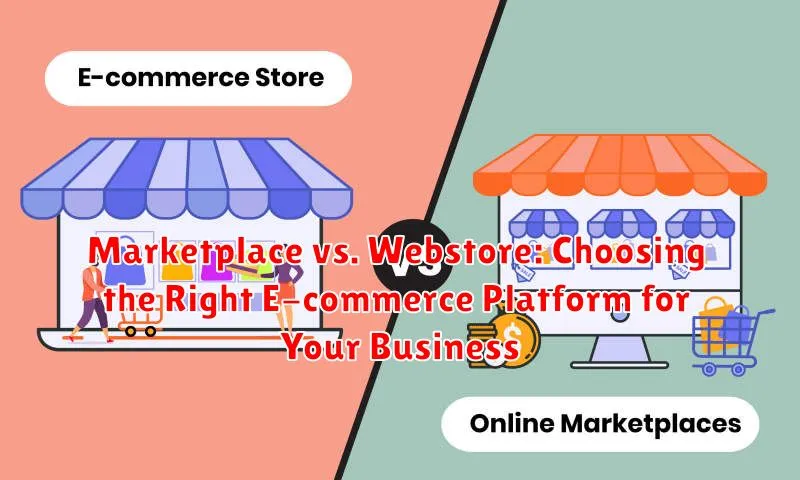Launching your e-commerce business requires careful consideration of the right platform. Two primary options dominate the landscape: marketplaces and webstores. Each presents distinct advantages and disadvantages, making the decision crucial for your success. This article explores the key differences between marketplaces like Amazon, Etsy, and eBay, and webstores, often powered by platforms like Shopify and WooCommerce. Understanding these differences will empower you to choose the e-commerce platform that best aligns with your business goals, resources, and target audience. We will delve into the nuances of marketplace selling versus establishing your own dedicated online store, providing a comprehensive guide to help you make an informed decision.
Choosing between a marketplace and a webstore is akin to selecting between renting a retail space in a bustling mall and constructing your own standalone storefront. Marketplaces offer immediate access to a vast customer base and established infrastructure, while webstores provide greater control over branding, customer experience, and data. This article will examine the core aspects of each platform, including cost, control, branding, customer relationships, and scalability. By analyzing these factors in the context of your specific business needs, you can strategically position yourself for e-commerce success, regardless of whether you opt for the integrated ecosystem of a marketplace or the autonomy of a dedicated webstore.
Understanding the Core Differences Between Marketplaces and Webstores
Choosing the right e-commerce platform is crucial for your business’s success. A key decision lies in selecting between a marketplace and a webstore. Understanding their core differences is paramount.
Marketplaces are essentially online shopping malls. They host multiple third-party sellers under one roof, providing built-in traffic and a simplified selling process. Think Amazon, Etsy, or eBay. You list your products alongside competitors, benefiting from the marketplace’s existing customer base.
Webstores, conversely, are independent online shops. You have complete control over branding, design, and customer experience. Imagine owning a boutique on a bustling street. You build your brand identity and cultivate customer loyalty directly.
The core difference lies in control and reach. Marketplaces offer vast reach but limited control, while webstores provide extensive control but require effort to build reach.
Advantages of Selling on an Online Marketplace

Marketplaces offer several compelling advantages for businesses, especially those starting out or looking to expand their reach quickly. One primary benefit is built-in traffic. Marketplaces already have a large, established customer base actively searching for products, providing instant access to a wider audience than a standalone webstore might initially attract.
Simplified setup is another key advantage. Creating a seller account and listing products is generally a streamlined process, allowing businesses to start selling relatively quickly. Marketplaces handle the complex backend infrastructure, including payment processing and security, reducing the technical burden on sellers.
Furthermore, marketplaces often provide marketing and promotional support, featuring products in special promotions or advertising campaigns. This can significantly boost product visibility and drive sales, particularly for newer businesses.
Finally, some marketplaces offer fulfillment services, handling storage, shipping, and returns, which can simplify logistics and save businesses time and resources.
Disadvantages of Selling on an Online Marketplace
While marketplaces offer a readily available customer base, they also present certain limitations. Competition is often fierce, with numerous sellers vying for the same customer’s attention. This can lead to price wars and reduced profit margins.
Marketplaces impose fees, which can cut into your profits. These can include listing fees, transaction fees, and even fees for utilizing certain marketplace features. Understanding the fee structure is crucial for calculating your true profit potential.
Branding opportunities are limited on marketplaces. You’re often restricted in how you present your brand and products, potentially hindering your ability to build a unique brand identity and customer loyalty.
Marketplaces control the customer data. You typically have limited access to customer information, making it difficult to build direct relationships with your buyers and implement targeted marketing strategies.
Finally, marketplaces have their own rules and regulations that you must adhere to. These rules can be strict and change without notice, potentially impacting your business operations.
Benefits of Having Your Own Webstore
Owning a webstore offers significant advantages for businesses seeking greater control and brand building opportunities. Branding is a key benefit, allowing you to cultivate a unique brand identity and customer experience through customized design and messaging. This fosters stronger customer loyalty and recognition.
Control over every aspect of the sales process is another compelling benefit. You dictate pricing, promotions, and customer service policies, creating a tailored shopping experience. This level of control extends to data collection and analysis, providing valuable insights into customer behavior and preferences.
Flexibility is paramount with a webstore. You’re not bound by marketplace regulations and can easily adapt to changing market trends and customer demands. This includes offering personalized promotions, implementing unique shipping strategies, and integrating specialized tools to enhance the customer journey.
Finally, webstores offer the potential for higher profit margins. By eliminating marketplace commissions and fees, you retain a larger portion of your sales revenue, maximizing profitability and reinvestment opportunities.
Drawbacks of Running a Webstore
While owning a webstore offers significant control and branding opportunities, it also presents some challenges.
Attracting traffic is a major hurdle. Unlike marketplaces with built-in customer bases, webstores require dedicated marketing and SEO efforts to drive visibility and generate sales. This often involves considerable time and financial investment.
Building and maintaining the website itself can be complex. This encompasses design, development, security, and ongoing technical upkeep. Businesses may need to hire specialized personnel or outsource these tasks, adding to operational costs.
Handling all customer service inquiries falls solely on the webstore owner. This includes managing returns, addressing complaints, and providing technical support, which can be time-consuming, especially as the business grows.
Building trust and credibility with customers takes time and effort. New webstores lack the established reputation of marketplaces, requiring proactive measures to build confidence and encourage purchases. This can involve implementing secure payment gateways, offering robust return policies, and actively soliciting customer reviews.
Key Factors to Consider When Making Your Decision
Choosing between a marketplace and a webstore requires careful evaluation of several key factors. Your business size and scale play a crucial role. Startups or small businesses might find marketplaces easier to launch on due to the existing infrastructure and customer base. Larger, established businesses might prefer the control and branding opportunities of a webstore.
Budget is another critical consideration. Marketplaces typically involve commission fees and listing costs, while webstores require upfront investment in website development and maintenance. Consider your existing resources and projected revenue when evaluating these costs.
Technical expertise is essential for managing a webstore. If you lack in-house technical skills, you might need to hire developers or outsource maintenance, adding to the overall cost. Marketplaces handle the technical aspects, making it easier for businesses with limited technical resources.
Your desired level of control over branding and customer experience should also factor into your decision. Webstores offer complete control over design, messaging, and customer interactions, allowing for a more cohesive brand experience. Marketplaces have pre-set guidelines that can restrict customization options.
Making the Right Choice for Your Business Needs

Selecting between a marketplace and a webstore hinges on aligning the platform with your specific business objectives. Carefully evaluate your resources, growth plans, and desired level of control.
For businesses prioritizing rapid market entry and minimal upfront investment, a marketplace often presents a compelling solution. Leveraging an established customer base provides immediate visibility and sales potential. However, this convenience comes with trade-offs, including sharing revenue and limited branding opportunities.
Conversely, a webstore affords greater control over branding, customer experience, and data ownership. This approach demands more significant upfront investment and ongoing management. However, it cultivates stronger customer relationships and fosters long-term brand loyalty, potentially leading to higher profit margins and sustained growth.
Ultimately, the “right” choice depends on a careful assessment of your business’s unique circumstances and aspirations. Consider what level of control and customization is required, the resources available, and your long-term growth strategy.

